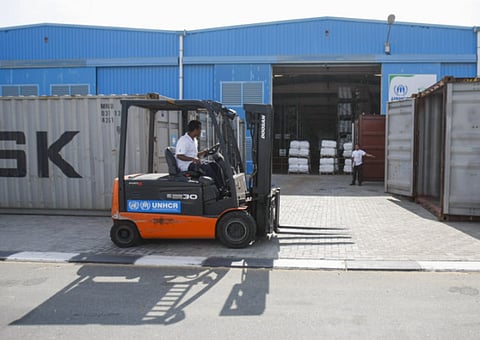Mind those distances at warehouses even with peak season in full swing
Jobs are being added at warehouses, but there can be no easing off on safety

The pandemic has changed the way we live and shop. US ecommerce sales started skyrocketing in March 2020 and has shown no signs of slowing down since.
As ecommerce players prepare for what’s sure to be another busy holiday season this year, many have already announced plans to add thousands of new employees. This additional labor will be necessary for unifying shopping channels and fulfilling customers’ orders no matter where they’re going.
But that also presents a significant challenge: How do you maintain proper social distancing as employee numbers grow? Fortunately, technology can help manufacturers and transportation and logistics companies limit close-contact situations as they hire new to support demand.
Distance tracking
Proximity monitoring solutions that either slip onto a worker’s wrist or embedded into their mobile devices are now widely available. These help employees maintain a safe distance by issuing an alert when two or more employees get too close.
But solutions that simply “beep” to alert employees when they move too close don’t go far enough. The most useful proximity monitoring solutions also record the time and location of proximity “events”, which occur when employees are spaced too closely together for a more extended, pre-specified length of time, such as five minutes.
Recording these events not only allows managers to identify and eliminate potential danger areas where worker congestion is high, but also allows for quick contact tracing if an employee tests positive for COVID-19.
Get ‘cobots’ to work
An increasing number of companies are “hiring” collaborative robots, or cobots, to reduce the burden of repetitive tasks on employees and minimize human-to-human contact. About 2.7 million robots now work in factories worldwide – an increase of 12 per cent from last year.
Many manufacturers and ecommerce warehouse operators use cobots to transport orders and materials from the main building to the loading dock to help increase productivity. These material handling robots can also help prevent disease spread by limiting the number of employees on the manufacturing or warehouse floor.
Reengineer workflow
To keep workers successfully spaced, companies are changing the way they do business. For instance, many warehouses were previously set up to accommodate an order-based picking system, where employees might grab a pallet jack and pick an entire order at once. This workflow design can be very efficient.
But it also results in a lot of cross-mingling between workers. Today, some warehouse operators are moving to a zone-based order system, where an employee is dedicated to one aisle and never leaves his or her zone.
Again, cobots or autonomous mobile vehicles (AMVs) can help this process by transferring a half-completed order to the next zone for completion. In a zone-based system, picking errors can be easily missed as packed materials are transported from one zone to another – and replacing missing or incorrect items can be very time-consuming.
This model makes it even more critical to error-proof the process. Arming pickers with tools like barcode and RFID scanners as well as smart glasses, can help ensure the right items go in the right box or pallet before being transferred to the next zone.
Companies are also changing training and employee communications processes to reduce the potential for the spread of infections. Some companies are replacing in-person training with mobile device videos or the daily employee “huddle” with department-wide conference calls to reduce contact between employees.
Rethinking operations
Companies have turned to lean manufacturing techniques to minimize waste in the manufacturing process while maximizing productivity. That’s why even before the start of the pandemic, 75 per cent of warehouse operators had already equipped their employees with purpose-built devices and technology to increase efficiency, speed and accuracy.
In a post-COVID-19 world, industry leaders are continuing to look for new ways to maximize efficiency while minimizing human contact to help maintain productivity while also keeping employees safe.
- Mark Thomson is Director of Retail Industry Solutions at Zebra Technologies.
Sign up for the Daily Briefing
Get the latest news and updates straight to your inbox







